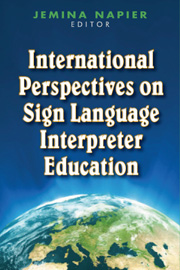Jemina Napier, Editor
|
View the table of contents. View the list of contributors. Read an excerpt. Read a review. |
$75.00s print edition $75.00 e-book |
Interpreter Education, Volume 4
From Interpreting, International Journal of Research and Practice in Interpreting, cont’d.
The last European country to be covered is Sweden. Anna Hein explains that although Swedish Sign Language is not recognized as a minority language, it was officially recognized as the first language of deaf people in 1981, and anyone who “does not speak Swedish or is impaired in speech and/or hearing” has the legal right to an interpreter (p. 124). She gives a detailed account of SLI provision, starting with TÖI, the Institute for Interpreting and Translation Studies, at Stockholm University, which has provided public service interpreter training in both spoken and signed languages since 1968, mainly in the fields of medical care and social welfare. However, most training is provided in adult education centres or at liberal adult education colleges, the funding and supervision of which is controlled by TÖI. Hein covers the main aspects of the Swedish system such as enrolment, programme content and assessment, and describes the close collaboration between TÖI, the colleges and representatives of the interpreter agencies.
The first contribution in Part Two, from Asia-Pacific countries, is offered by Karen Bontempo and Patricia Levitzke-Gray from Australia, a giant country in size hut with a relatively small deaf population. Government policies dating from the 1980s and 1990s, favourable to social access and opportunity for deaf people, changed SLI in positive ways, such as formal training, standardized national testing and the founding of several interpreter associations. The first university level (post-graduate) SL training course in Australian Sign Language (Auslan) began at Macquarie University in Sydney in 2002. Interest in establishing undergraduate programmes has since been expressed in several states. As in Sweden, many Australian non-university institutions provide SL training but with less homogeneity in terms of location, recruitment, course content, assessment etc. There is a public service focus, with educational interpreting being the fastest-growing area of demand. An interesting development owing to the great distances was the introduction in 2007 of distance learning technology for students. It has since been offered also to Auslan interpreters living in inaccessible marginal parts of the country. In Australia there is a lack of deaf trainers and the status and training of deaf relay interpreters is still open to debate, remaining underfunded and unrecognized.
The tiny island state of Fiji in the Pacific Ocean offers a second example of newly emerging SL interpreter training. Kate Nelson, Inise Tawaketini, Ruth Spencer and Della Goswell explain how Deaf community development was stifled from the 1 960s by deaf children being placed in special schools for the disabled. There was no provision of education that catered to their deafness-related needs until 1967 when an Australian took over one of the schools and provided separate instruction for them. Fijian deaf children and adults could use home signs and borrow mouthing from the three official languages, Fijian (Bauan), Hindustani (Fiji Hindi) and English, but there was no standardized Fiji Sign Language (FJSL) and little social contact among deaf individuals to encourage its development. Over four decades, sign languages from other countries made their impact on the development of FJSL: Australian Signed English (ASE), Signed Exact English (SEE) and New Zealand Sign Language (NZSL). The Fiji Association of the Deaf, set up in 2002, called Australian volunteers to create an FJSL dictionary and provide interpreter training. The authors give a thorough description of a six-month course in 2006 and conclude, on a positive note, that FJSL is now evolving on the islands and interpreters are developing their skills in tandem.
Despite the founding of the Japanese Federation of the Deaf (JFD), Eiichi Takada and Shin’ichi Koide explain how the development of SLI in Japan has been hindered by discriminatory customs and views against the disabled. In 1963 a citizens’ volunteer group was formed, supported by the JFD, called Mimizuku to befriend deaf people and learn SL. By the late 1960s, members of the group and others became volunteer interpreters and began lobbying the government and this led to the first government-funded training of interpreters in 1970. Training continued under social welfare programmes but was kept separate from the spoken language interpreter training provided in educational institutions. A new Sign Language Interpreting Project set up by the Ministry of Labour and Welfare is described with information regarding certification, interpreter associations and the National Sign Language Research Center.
Jemina Napier is a professor and chair of Intercultural Communication in the Department of Languages and Intercultural Studies at Heriot-Watt University in Scotland.
Print Edition: ISBN 978-1-56368-411-1, 6 x 9 casebound, 328 pages, 7 tables, 16 figures, appendices
$75.00s
E-Book: ISBN 978-1-56368-458-6
$75.00
To order by mail, print our Order Form or call:TEL 1-800-621-2736; (773) 568-1550 8 am - 5 pm CST
TTY 1-888-630-9347
FAX 1-800-621-8476; (773) 660-2235
